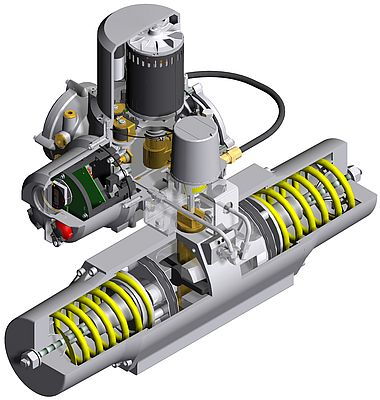Comprehensive Guide to Electro-Hydraulic Actuators
On this page
Electro-hydraulic actuators represent an advanced industrial control device driven by electrical signals to power hydraulic systems. They are particularly suited for applications requiring high thrust, large stroke, and precise control. Compared to pneumatic and electric actuators, electro-hydraulic actuators achieve greater thrust or torque through hydraulic mechanisms, offering rapid response times and precise positional control.
Electro-hydraulic actuators are composed of two main sections: the actuator unit and the control box, each playing crucial roles in their operation and functionality.
Cylinders: These are the primary components responsible for converting hydraulic pressure into mechanical force, facilitating precise linear or rotary motion.
Electro-Hydraulic Power Components: This includes various elements such as motors, gear pumps, and flow matching valves. Motors convert electrical energy into mechanical power, which is then transmitted to hydraulic systems through gear pumps. Flow matching valves ensure accurate control of hydraulic fluid flow, optimizing operational efficiency and performance.
Position Control Processor (PCP): Installed remotely, the PCP serves as the brain of the electro-hydraulic actuator system. It translates external electrical signals into specific positional commands, ensuring precise control over the actuator's movements.
Power Supply and Motor Drivers: Essential for providing electrical power to the actuator system and controlling motor operations, ensuring consistent and reliable performance.
Safety and Monitoring Features: The control box incorporates safety mechanisms such as fuses, power filters, and diagnostic tools to monitor system health, detect faults, and prevent potential operational hazards.
Electro-hydraulic actuators operate by utilizing electrical signals to activate hydraulic components, achieving superior force and torque compared to pneumatic or purely electric systems. This capability makes them ideal for applications requiring high thrust, extended travel distances, and precise positional accuracy.
Electro-hydraulic actuators operate based on a sophisticated system of electrical signals and hydraulic power, designed to achieve precise motion control in industrial applications requiring high performance and accuracy.
Conversion of Electrical Signals: The operation begins with external electrical signals received by the Position Control Processor (PCP) within the control box. These signals specify the desired position or movement of the actuator.
Hydraulic Power Conversion: Inside the actuator unit, electrical energy is converted into hydraulic power. This conversion is facilitated by components such as motors and gear pumps, which generate hydraulic pressure proportional to the electrical input.
Mechanical Motion: The hydraulic pressure generated is used to actuate cylinders or other mechanical elements within the actuator unit. This results in precise linear or rotational motion as required by the application.
Position Control Processor (PCP): The PCP plays a pivotal role in controlling the electro-hydraulic actuator's movement. It interprets the incoming electrical signals to determine the exact position or movement required.
Feedback System: To ensure accuracy, the actuator incorporates feedback devices such as sensors. These sensors continuously monitor the actual position of the actuator and provide feedback to the PCP.
Closed-Loop Control: Using the feedback received, the PCP adjusts the operation of hydraulic components (motors, pumps) to achieve and maintain the desired position or movement accurately. This closed-loop control mechanism ensures precise and reliable performance.
Automatic Mode: In automatic mode, the PCP autonomously adjusts the actuator's position based on predefined parameters and input signals, optimizing efficiency and accuracy.
Manual Local Mode: For manual operations or local adjustments, the control box may allow operators to manually control the actuator's position using local controls, providing flexibility in operational scenarios.
Calibration Mode: Calibration mode facilitates fine-tuning and adjustment of the actuator's performance parameters, ensuring alignment with specific operational requirements and environmental conditions.
Safety Features: The control system incorporates safety measures such as overload protection, emergency stop functions, and diagnostic capabilities to detect and respond to faults promptly.
Fault Diagnosis: Through continuous monitoring and feedback, the PCP can diagnose potential faults or deviations from expected performance. It alerts operators to take corrective actions to prevent operational disruptions or equipment damage.
The power module of electro-hydraulic actuators comprises essential components that convert electrical energy into hydraulic power, enabling precise control over actuator movements. Key components include:
Motor: Converts electrical energy into mechanical power, driving the hydraulic pump.
Hydraulic Pump: Generates hydraulic pressure by pumping hydraulic fluid (often oil) into the actuator cylinders or motors, translating electrical signals into mechanical force.
Oil Reservoir: Stores hydraulic fluid, ensuring a continuous supply for smooth operation and maintaining system pressure.
The flow matching system is integral to optimizing energy efficiency and operational performance in electro-hydraulic actuators. It includes:
Flow Matching Valve (FMV): This valve controls the flow of hydraulic fluid, adjusting the rate at which fluid enters the actuator based on demand. By precisely matching flow to the actuator’s needs, the FMV minimizes energy consumption and reduces operational costs.
Incremental Positioning: The system allows for incremental positioning of the actuator. It activates the motor and pump only when movement is required, conserving energy and enhancing efficiency.
Energy Savings: By reducing unnecessary hydraulic fluid flow during idle periods, the flow matching system maximizes energy efficiency, contributing to lower operational costs and environmental sustainability.
To ensure stable operation and safety, the control box design incorporates multiple safety measures such as fuses and power filters. The PCP not only monitors position and action status in real-time but also accurately diagnoses and alarms various potential actuator faults, enabling prompt maintenance actions to prevent production interruptions and equipment damage.
Through this detailed overview, electro-hydraulic actuators demonstrate their importance and advantages in industrial automation control and precision mechanical movements. Their high precision and efficiency make them indispensable in modern industries, widely applied in aerospace, automotive manufacturing, heavy machinery, and other fields, providing reliable solutions for complex motion control.

